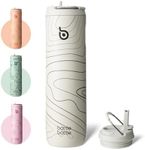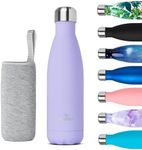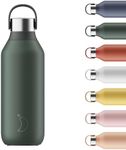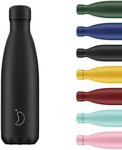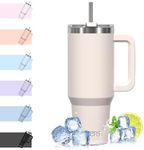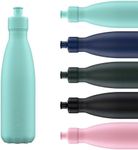Buying Guide for the Best Insulated Water Bottles
Choosing the right insulated water bottle can make a big difference in your daily hydration routine. Insulated water bottles are designed to keep your beverages at the desired temperature for extended periods, whether you want to keep your water cold during a hot day or your coffee hot on a chilly morning. To find the best fit for you, consider the following key specifications and how they align with your needs and lifestyle.MaterialThe material of an insulated water bottle is crucial as it affects durability, weight, and insulation performance. Common materials include stainless steel, plastic, and glass. Stainless steel is highly durable and offers excellent insulation, making it ideal for outdoor activities and long-term use. Plastic bottles are lighter and often more affordable but may not keep beverages hot or cold as long as stainless steel. Glass bottles provide a clean taste and are free from chemicals but are more fragile. Choose a material based on your priorities, such as durability for hiking or a clean taste for everyday use.
Insulation TypeInsulation type determines how well the bottle maintains the temperature of your beverage. The most common types are double-wall vacuum insulation and foam insulation. Double-wall vacuum insulation is the most effective, keeping drinks hot or cold for many hours, making it perfect for long trips or all-day use. Foam insulation is less effective but can still keep beverages at the desired temperature for a few hours, suitable for shorter outings or daily commutes. Consider how long you need your drink to stay hot or cold when choosing the insulation type.
CapacityCapacity refers to the volume of liquid the bottle can hold, typically measured in ounces or liters. Smaller bottles (12-16 ounces) are compact and easy to carry, ideal for short trips or when you need to travel light. Medium-sized bottles (20-32 ounces) offer a balance between portability and capacity, suitable for daily use or moderate activities. Larger bottles (40 ounces or more) provide ample hydration for long hikes, workouts, or all-day events but can be heavier and bulkier. Choose a capacity that matches your hydration needs and how you plan to use the bottle.
Lid TypeThe lid type affects the convenience and functionality of the bottle. Common lid types include screw-on, flip-top, and straw lids. Screw-on lids are secure and prevent leaks, making them great for travel and outdoor activities. Flip-top lids offer quick access to your drink, ideal for on-the-go use or during workouts. Straw lids allow for easy sipping without tilting the bottle, perfect for driving or multitasking. Consider how you will use the bottle and choose a lid type that offers the best combination of convenience and security for your lifestyle.
Ease of CleaningEase of cleaning is important to maintain hygiene and ensure the longevity of your bottle. Bottles with wide mouths are easier to clean by hand and can accommodate ice cubes or cleaning brushes. Some bottles are dishwasher safe, which can save time and effort. Additionally, consider if the bottle has any small parts or complex lids that might be difficult to clean thoroughly. If you plan to use the bottle frequently or for different types of beverages, choose one that is easy to clean to prevent odors and residue buildup.
DurabilityDurability is a key factor, especially if you plan to use the bottle for outdoor activities or in rugged conditions. Stainless steel bottles are generally the most durable, resistant to dents and scratches. Plastic bottles can be durable but may be prone to cracking or warping over time. Glass bottles are the least durable but often come with protective sleeves to reduce the risk of breakage. Consider how and where you will use the bottle and choose a material that can withstand your intended use.
WeightThe weight of the bottle can impact its portability and ease of use. Stainless steel bottles tend to be heavier but offer superior insulation and durability. Plastic bottles are lighter and easier to carry but may not keep beverages at the desired temperature as long. Glass bottles are typically heavier and more fragile. If you need a bottle for activities like hiking or commuting, where weight is a concern, opt for a lighter material. For stationary use or when insulation is a priority, a heavier bottle may be acceptable.
